| Volume
104
Colonial Mexico (January, 2004)
Among cruisers on this side of Mexico, the three most popular inland trips are Oaxaca, Copper Canyon and Colonial Mexico. With our time in Mexico counting down, January was our window to squeeze in the last of the list to Colonial Mexico. It was also a last hurrah for our close friendship with Dennis and Lisa of Lady Galadriel, who, headed to Central America, would be parting ways with us afterward. 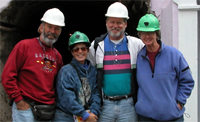
With hindsight, January would not be the month we would recommend to anyone else to make this trip. Cruisers in these latitudes are not very well equipped for cold weather, and neither, it turns out, are Mexican buildings. Here we were in one of the historically richest regions of a culturally diverse country, and the thing we will all remember most was how cold we were!
Colonial Mexico is a label given to a large zone encompassing six states in the highlands northwest of Mexico City. Touristically speaking, it stretches from the city of Morelia in Michoacan northward to
Querétaro, San Miguel de Allende, Dolores Hidalgo, and Guanajuato all the way up to Zacatecas. These cities are typified by beautiful colonial architecture in their centros, most of which was funded by the rich mines of silver and other metals which drew Spanish settlers to these highlands in the mid-1500s. Additionally, the countryside around them is one of Mexico's major agricultural regions. With all these assets, the region thrived.
Not so coincidentally, this same area is also known as the cradle of the movement for independence from Spain in the early 1800s. Much as happened in America to the north, colonists of Nueva
España -- in particular the successful colonists -- began to resent the control over their lives and fortunes by the distant Spanish crown. Spain also practiced a discriminatory racial hierarchy based not only on ethnicity, but simply on whether or not you'd been born in the home country or in the colonies. At the same time, Spain was trying to consolidate its hold on Nueva
España by weakening the power of the Catholic church here. These and many other factors fomented a discontent that burst into rebellion on September 16, 1810 when the priest Miguel Hidalgo issued his famous
"Grito de Independencia" from the town of Dolores. He led followers on a circuit that looped from San Miguel, to Guanajuato, to Zacatecas and back south to Guadalajara until he was captured and executed on July 30, 1811. His head, along with those of his co-conspirators, was hung from a corner of the huge granary in Guanajuato where it hung for ten years!
Many options were open to us for touring Colonial Mexico, including a five-day train trip from Mexico City that was tempting, but we finally decided to take a bus from
Mazatlán to Guadalajara and to pick up a rental car there. We spent our first night in Tlaquepaque at the same charming B&B
-- the Quinta Don Jose (www.quintadonjose.com) -- that I had been introduced to a year ago on my
"Girl's Trip" inland with Jan Loomis. The weather as evening approached was chill and drizzly, and, as we sipped our welcome margaritas in the B&B's charming little bar area
-- that would have been snug if the door had been closed and some heat supplied, we had our first doubts about the timing of our trip.
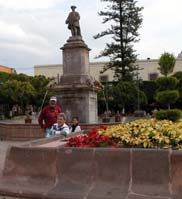 laquepaque is a suburb of Guadalajara -- Mexico's second largest city. The suburb was once a weekend getaway for Guadalajara's well-to-do, but recently the mansions have been transformed into galleries and shops displaying the work of local artisans. The Jardin Hidalgo, bracketed by two churches, is the center of this gentrification, from which a pedestrian mall lined with shops runs westward for four blocks. On Sunday evenings the stores are all closed (it is written in the stars that I shall not get there when the stores are OPEN!), but the square is lined with food vendors and everyone is out strolling to see and be seen. However, the drizzle had cut the numbers and the enthusiasm back quite a bit, and we scurried through to catch a nice dinner at Casa Vieja, before hurrying back to snuggle under the covers! laquepaque is a suburb of Guadalajara -- Mexico's second largest city. The suburb was once a weekend getaway for Guadalajara's well-to-do, but recently the mansions have been transformed into galleries and shops displaying the work of local artisans. The Jardin Hidalgo, bracketed by two churches, is the center of this gentrification, from which a pedestrian mall lined with shops runs westward for four blocks. On Sunday evenings the stores are all closed (it is written in the stars that I shall not get there when the stores are OPEN!), but the square is lined with food vendors and everyone is out strolling to see and be seen. However, the drizzle had cut the numbers and the enthusiasm back quite a bit, and we scurried through to catch a nice dinner at Casa Vieja, before hurrying back to snuggle under the covers!
In the morning after breakfast, National delivered our rental car right to the B&B, a convenience that got us underway with a minimum of fuss. Our destination was
Querétaro about 350 kilometers away, but there was a little suspense to getting out of the city. Mexico has a network of autopistas that are modern, high-speed toll roads. It was our intent to take the autopista, but the signs for them would leap up with no warning, and we'd miss the turnoffs time and time again. Instead we traveled more slowly on the
"free roads", which, once we were finally convinced we were headed in the right direction and not trapped in some urban maze, proved much to our liking.
Querétaro was the actual home base of the 18th century independence movement. Although geographic fame ended up elsewhere, the conspirators used to meet in
Querétaro at the home of Dona Josepha Ortiz, wife of a former district administrator, until they were found out. Dona Ortiz was imprisoned, but she managed to get warning out to the other conspirators in time for Hidalgo to launch the movement in Dolores, making her a female hero of the revolution. Like all of the historic cities we would visit,
Querétaro's historic center is nestled deep in the heart of modern urban sprawl. We found our way into the centro, found lodging just outside the old quarter in a clean and inexpensive businessmen's hotel (where only one towel was provided per room!) and walked in the surprisingly mild afternoon all through the colonial section. We had hoped to link up with an organized walking tour at the tourist office, but these have been abandoned in favor of bus tours. 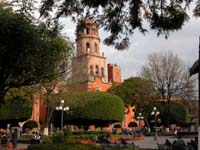 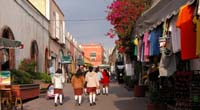
Such a shame in a town like Querétaro where andadores -- narrow pedestrian walks
-- twist their way among houses and squares and cobblestone streets. We found we could do our own tour pretty well with the Lonely Planet in hand, and we caught all the important statues and churches. We took wine and cheese on the Plaza de la Corregidora (site of Dona Ortiz's home), and then eschewed the pricier restaurants to graze on tacos in one shop and gorditas in another. The gorditas in
Querétaro -- fat, greasy stuffed 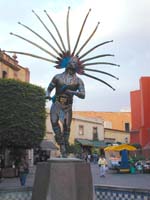 tortillas -- were reminiscent of the pupusas of El Salvador and made us feel like fat gorditas after eating them. On our way out of town the next morning, we drove beneath the arches of
Querétaro's 18th century aqueduct which still brings in water to the city. tortillas -- were reminiscent of the pupusas of El Salvador and made us feel like fat gorditas after eating them. On our way out of town the next morning, we drove beneath the arches of
Querétaro's 18th century aqueduct which still brings in water to the city.
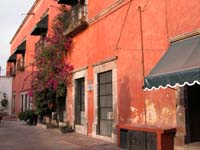 Our next stop was San Miguel de Allende about 60km away. San Miguel has quite a reputation as a mecca for transplanted gringos. Cruisers we met in El Salvador had recently bought a house there and sang its praise strongly. Long in the back of our minds was the hope we'd be able to coordinate a visit there when John and Patricia of Ragtime were home. It would have been interesting to see the town from a resident's viewpoint. The highway from
Querétaro approached up a steady rise to a sudden steep drop into town. The view was gorgeous over the tops of tightly-packed rooftops to a broad valley with a winding river in the distance. Our next stop was San Miguel de Allende about 60km away. San Miguel has quite a reputation as a mecca for transplanted gringos. Cruisers we met in El Salvador had recently bought a house there and sang its praise strongly. Long in the back of our minds was the hope we'd be able to coordinate a visit there when John and Patricia of Ragtime were home. It would have been interesting to see the town from a resident's viewpoint. The highway from
Querétaro approached up a steady rise to a sudden steep drop into town. The view was gorgeous over the tops of tightly-packed rooftops to a broad valley with a winding river in the distance. 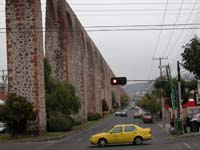
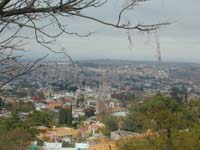 The town descends the hillside in steep streets and staircases to a beautiful plaza
-- the Jardin (garden)-- at its center, watched over by the two distinctive gothic spires of San Miguel's parroquia (parish church). Miraculously, we found a parking place right near the town's center and chose an inexpensive hostel conveniently nearby. Then we set out to walk the town, again eschewing the paid tour for the guidebook. We wandered all over, up hill and down, in and out of churches and museums, checking out restaurants, and generally admiring the local architecture. The town descends the hillside in steep streets and staircases to a beautiful plaza
-- the Jardin (garden)-- at its center, watched over by the two distinctive gothic spires of San Miguel's parroquia (parish church). Miraculously, we found a parking place right near the town's center and chose an inexpensive hostel conveniently nearby. Then we set out to walk the town, again eschewing the paid tour for the guidebook. We wandered all over, up hill and down, in and out of churches and museums, checking out restaurants, and generally admiring the local architecture.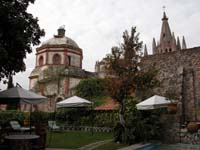 In the Parque Benito Juarez, a surprising chunk of woods right in town, we chanced on a bare-chested toreador, practicing his cape work for the bull ring several blocks away. At the bottom of the park, we found our way into the Instituto Allende, once the residence of the Canal family, but now a busy art and language school, one of the draws to the town's many visitors. After looking into several studios where activities as diverse as sculpture and weaving were underway, we found our way in for a mid-afternoon cervesa to the Institute's own restaurant (Italian),where a fire burned merrily in a huge raised hearth. In the Parque Benito Juarez, a surprising chunk of woods right in town, we chanced on a bare-chested toreador, practicing his cape work for the bull ring several blocks away. At the bottom of the park, we found our way into the Instituto Allende, once the residence of the Canal family, but now a busy art and language school, one of the draws to the town's many visitors. After looking into several studios where activities as diverse as sculpture and weaving were underway, we found our way in for a mid-afternoon cervesa to the Institute's own restaurant (Italian),where a fire burned merrily in a huge raised hearth.
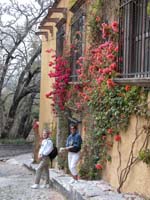
That night we dressed up as much as the weather and wardrobe would permit for an upscale dinner at a restaurant on the hill we'd liked the look of. Belonging to an upscale hotel, the Riviera had a great view over of the tops of the churches domes and spire. The atmosphere, however, was better than the food, which was good but not memorable. More memorable was a great breakfast we had the next morning in a outdoor cafe near the American consulate. Afterwards we walked the lower, northern part of town, strolling through the two markets (food and crafts) and several more churches
-- templos, capillas, oratorios, parroquias, and iglesias!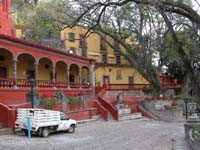
This is probably a good place to point out that before this trip churches were on the list as a recognized obligation, but not a real attraction, at least to the 2Cs. Fortunately, Lisa insisted, and the more you see, the more interesting they become. Raised Catholic, Lisa was a helpful, if rusty, interpreter of what we were seeing. There is quite a variety. Some are rather plain on the outside and then opulent on the inside with gold leaf and/or dark brooding oil paintings, while others are
"iced" on their outsides with elaborate Churrigueresque carvings and simple on the inside. Any variation on the combination is possible, and we saw through the course of the trip at least a half dozen ways to depict the stations of the cross. The 18th century Churrigueresque church fronts and their baroque predecessors, however, were a common thread in the colonial zone we were traveling, and no one could be immune to the craftsmanship that went into the stonework.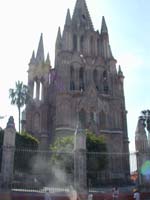
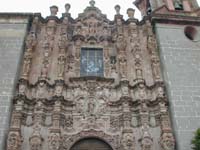 From San Miguel we drove northwest to Guanajuato. Our road led us through the town of Dolores Hidalgo, so we diverted to stop at the church where, on September 16, 1810, Miguel Hidalgo issued his call for independence. Although the town is plainer than most we visited, the parroquia seemed very large. From San Miguel we drove northwest to Guanajuato. Our road led us through the town of Dolores Hidalgo, so we diverted to stop at the church where, on September 16, 1810, Miguel Hidalgo issued his call for independence. Although the town is plainer than most we visited, the parroquia seemed very large.
Inside we were puzzled by the difference in the naves on either side of the altar. Both featured heavily carved wooden walls, but one was heavily gilt in gold leaf while the other side was all but plain. Lisa and I queried a Mexican gentleman also visiting, and he explained that the gilt side honors the Virgin of Guadalupe, whom the Lonely Planet describes as
"Mexico's most binding symbol" explaining, for you non-religious readers, that
"the dark skinned Virgin of Guadalupe (is) a manifestation of the
Virgin Mary who appeared to an indigenous Mexican in 1531 on a hill
near Mexico City."
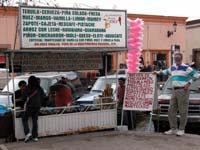 Outside on the other side of the plaza we found Dolores Hidalgo's other tourist attraction: ice cream! Seriously! There were two vendors there selling ice cream cones in dozens of unusual flavors, like beer, tequila, avocado, mole, shrimp, and pine nut to name just a few. The guys with the scoops were quick to offer tastes, which helped solve the problem of experiencing the variety, but ending up with a cone you liked. Everybody bought tequila, which was tasty, except me who bought pine nut, which was even tastier! While licking our cones we paused to chat with some other ex-pat Americans, who recommended a turnoff to small town called Santa Rosa, where, they said, they'd stumbled on the highlight of their road trip -- beautiful pottery at very cheap prices! Dolores Hidalgo itself, we were surprised to see, is a sort of subcenter of the Talavera pottery and tiles which had so entranced me in Puebla last year. It is another debt the town owes Father Miguel Hidalgo, as it was he who established the first ceramics workshop here.
Outside on the other side of the plaza we found Dolores Hidalgo's other tourist attraction: ice cream! Seriously! There were two vendors there selling ice cream cones in dozens of unusual flavors, like beer, tequila, avocado, mole, shrimp, and pine nut to name just a few. The guys with the scoops were quick to offer tastes, which helped solve the problem of experiencing the variety, but ending up with a cone you liked. Everybody bought tequila, which was tasty, except me who bought pine nut, which was even tastier! While licking our cones we paused to chat with some other ex-pat Americans, who recommended a turnoff to small town called Santa Rosa, where, they said, they'd stumbled on the highlight of their road trip -- beautiful pottery at very cheap prices! Dolores Hidalgo itself, we were surprised to see, is a sort of subcenter of the Talavera pottery and tiles which had so entranced me in Puebla last year. It is another debt the town owes Father Miguel Hidalgo, as it was he who established the first ceramics workshop here.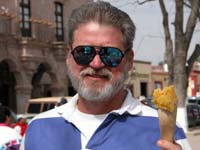
The road to Guanajuato from Dolores, appearing deceptively short on the map, climbed steadily into the mountains affording us twisting roads with views reminiscent of Copper Canyon. As we drove, clouds began to mass, adding to the drama. Over the top, we found the turnoff to Santa Rosa and drove the length of the tiny hamlet twice before we guessed which building was the pottery, but inside we found a true treasure trove. Filling two levels was shelf after shelf of Majolica-type pottery, all crafted by the members of one family!
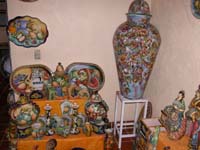 Unlike the primary colors and busy patterns of Talavera, this Majolica featured soft paintings of fruit, flowers and fish and came in every shape or function you could imagine. There were dozens of pieces I coveted; there was a whole rack of perfectly sized teapots, but sadly not a one with a lid! (they had not survived the kiln, evidently!), but as we had just gone through Tackless and off-loaded kilos of stuff that were not essential to our upcoming trip (much of which got carried home to Indiana), I couldn't let myself buy. Lisa and Dennis, who have a house back in Northern California, had no such compunctions. For some reason this realization that our chosen lifestyle doesn't permit such luxuries really hit home with force there in that mountaintop pottery, actually reducing me to tears. It could also have had something to do with the weather. It started to rain. Unlike the primary colors and busy patterns of Talavera, this Majolica featured soft paintings of fruit, flowers and fish and came in every shape or function you could imagine. There were dozens of pieces I coveted; there was a whole rack of perfectly sized teapots, but sadly not a one with a lid! (they had not survived the kiln, evidently!), but as we had just gone through Tackless and off-loaded kilos of stuff that were not essential to our upcoming trip (much of which got carried home to Indiana), I couldn't let myself buy. Lisa and Dennis, who have a house back in Northern California, had no such compunctions. For some reason this realization that our chosen lifestyle doesn't permit such luxuries really hit home with force there in that mountaintop pottery, actually reducing me to tears. It could also have had something to do with the weather. It started to rain.
We descended the road into Guanajuato, the most complicated city to navigate, in steadily increasing rain. The city is complicated because it was built in a deep gorge and not only has twisting, narrow, one-way streets (like one-way around the whole city!), but many of its streets travel through underground tunnels. 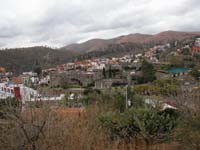 We, like many people, assumed the tunnels to be modifications of tunnels once used for mining, but except for the main roadway, which in fact is built in the channel where the Rio Guanajuato used to run, we were amazed to learn that the underground roads were, by and large, constructed beneath the city in recent decades to cope with the traffic. When you don't know where you are going in the first place, this is riotously disorienting. When with great good fortune we happened to pass near city's main plaza, the boys pulled over while Lisa and I jumped out and doubled back in hopes of finding a hotel room. We, like many people, assumed the tunnels to be modifications of tunnels once used for mining, but except for the main roadway, which in fact is built in the channel where the Rio Guanajuato used to run, we were amazed to learn that the underground roads were, by and large, constructed beneath the city in recent decades to cope with the traffic. When you don't know where you are going in the first place, this is riotously disorienting. When with great good fortune we happened to pass near city's main plaza, the boys pulled over while Lisa and I jumped out and doubled back in hopes of finding a hotel room.
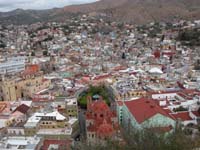 Once we did, we had to lead the desk clerk back to the car to help the guys drive back around else we might have lost them forever! Once we did, we had to lead the desk clerk back to the car to help the guys drive back around else we might have lost them forever!
The Hotel Luna, our choice among the several upscale hotels fronting the Jardin de la Union, was the most substantial hotel we stayed in on our trip. Dennis and Lisa opted for the pricier room with the antiques and the view through the rain of the plaza, while the 2Cs opted for the less expensive interior room with the king-sized bed. Both couples were happy! For dinner, we ventured out through the drizzle hoping to find a restaurant with more interesting food than the hotels. We discovered that the neighborhood also is home to the huge University of Guanajuato, so that the back streets were filled with small inexpensive eateries filled with students. For a change from Mexican, we opted for an Italian restaurant where we had delicious salads and pizzas and warming red wine.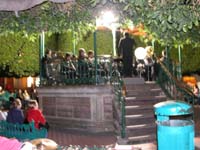
The next morning we partook of an organized tour available through the hotel, which allowed us to leave the car put. Even though the guide spoke no English, we would all insist this was one of the best moves of the trip. Our guide, full of enthusiasm for his subject, took great pains to ensure that Lisa and I were following with our halting Spanish. Unfortunately, he rarely left us a moment to translate for the guys. Our first site was the Alhondiga de Granaditas, a huge granary constructed at the end of the 18th century. During the revolution, the Spanish forces and loyalists took refuge in it, holding out against Hidalgo's rebels until one young miner was able to get close enough to set the doors on fire. Most of the people inside perished. In retribution for this deed, when the revolutionaries were captured and executed, it was from the corners of this same granary that the heads were hung in grisly display for ten years.
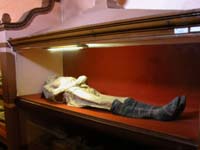 Speaking of grisly, our next stop on the tour was the Museo de las Momias. In the 19th century, Guanajuato's cemeteries began to get overcrowded, so a plan was devised to remove the bodies of those no one was caring (read
"paying") for. Speaking of grisly, our next stop on the tour was the Museo de las Momias. In the 19th century, Guanajuato's cemeteries began to get overcrowded, so a plan was devised to remove the bodies of those no one was caring (read
"paying") for. 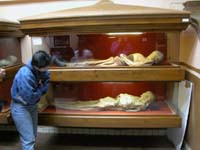 What they found were not skeletons, but naturally created mummies! Something to do with the minerals in the soil, the altitude and dryness of the air (obviously not this week!), and perhaps even something about the minerals in the water the locals had been drinking. In the museum are upwards of a hundred bodies, from babies and pregnant mothers to oldsters. We were none too sure what we'd feel about this exhibit, without the cultural benefit of the Mexican's obsession with death, but honestly it was pretty interesting. Thanks to the effects of expanding gasses which forces the corpses' mouths open, no one looked peaceful, but this grotesqueness was countered by amusing phenomenon that no one's socks had deteriorated. Hair does well too (although not
"hairdos") -- and not just head hair mind you. What they found were not skeletons, but naturally created mummies! Something to do with the minerals in the soil, the altitude and dryness of the air (obviously not this week!), and perhaps even something about the minerals in the water the locals had been drinking. In the museum are upwards of a hundred bodies, from babies and pregnant mothers to oldsters. We were none too sure what we'd feel about this exhibit, without the cultural benefit of the Mexican's obsession with death, but honestly it was pretty interesting. Thanks to the effects of expanding gasses which forces the corpses' mouths open, no one looked peaceful, but this grotesqueness was countered by amusing phenomenon that no one's socks had deteriorated. Hair does well too (although not
"hairdos") -- and not just head hair mind you.
From the mummies we climbed out of the gorge up to the mine -- the Valencia mine, to be specific -- which for 250 years produced 20% of the world's silver. We all doffed hard hats and followed a miner/guide into the tunnel leading deep into the mountain. The miner was not so careful to be sure we were understanding him, but we got the gist of things climbing up wooden ladders and looking down a 500m deep shaft!
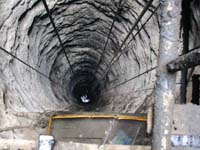
After the mine we stopped off at a beautifully restored building that had once been a private residence. I've lost my ticket stub from the tour, so I can't remember the specifics, only that it was built by a man who did good things, only to have it taken over by the Inquisition and turned into a prison.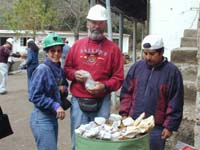 The displays of torture techniques in the bowels of this sunny beflowered hacienda were much more awful for the imaginative mind than the natural mummies. It is just incredible to look back on and consider man's cruelty to his fellows in the name of God and religion. As an antidote, our next stop was the very beautiful Templo La Valenciana. The church high on the hill overlooking the city was built by the Spaniard who started the mine, and legend has it that he pledged to built it if his patron saint made him rich. Lisa and I learned a lot about the differences in all the churches we had been seeing from our careful and considerate guide. Such interesting contrasts make up the Mexican national character. The displays of torture techniques in the bowels of this sunny beflowered hacienda were much more awful for the imaginative mind than the natural mummies. It is just incredible to look back on and consider man's cruelty to his fellows in the name of God and religion. As an antidote, our next stop was the very beautiful Templo La Valenciana. The church high on the hill overlooking the city was built by the Spaniard who started the mine, and legend has it that he pledged to built it if his patron saint made him rich. Lisa and I learned a lot about the differences in all the churches we had been seeing from our careful and considerate guide. Such interesting contrasts make up the Mexican national character.
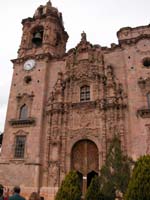
The tour ended a few statues and overlooks later at the Monumento a El Pipila (the young man who torched the granary). This was a statue and overlook combined with a fine view of the city from just above the Jardin, the Teatro Juarez with the statues of the nine muses on its roof and our hotel.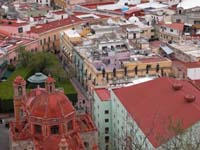 Let off nearby we took off on foot to find some food (it was now about 3pm), and to finish our tour of Guanajuato with the sites we could walk to. (Insert images 34-38.) Highlights were the very beautiful Basilica de Nuestra
Señora de Guanajuanto; the Callejon de Beso, an alleyway so narrow the occupants of opposing balconies can kiss; the cavernous Mercado Hidalgo, another steel fabrication by Gustav Eiffel; and finally the birthplace (now a museum) of the 20th century muralist Diego Rivera, whom I would venture to call another of Mexico's
"binding symbols." (If you haven't seen it already, be sure not to miss last year's movie hit Frida, available on video! It is a beautiful an excellent film based of the lives and passions of Rivera and his wife artist Frida Kahlo.) Clearly we had made the very best of our full day in Guanajuato, so the four travelers settled into Dennis and Lisa's hotel room for a supper of pork carnitas from the Mercado on Styrofoam plates Don bought from a hot dog vendor! Let off nearby we took off on foot to find some food (it was now about 3pm), and to finish our tour of Guanajuato with the sites we could walk to. (Insert images 34-38.) Highlights were the very beautiful Basilica de Nuestra
Señora de Guanajuanto; the Callejon de Beso, an alleyway so narrow the occupants of opposing balconies can kiss; the cavernous Mercado Hidalgo, another steel fabrication by Gustav Eiffel; and finally the birthplace (now a museum) of the 20th century muralist Diego Rivera, whom I would venture to call another of Mexico's
"binding symbols." (If you haven't seen it already, be sure not to miss last year's movie hit Frida, available on video! It is a beautiful an excellent film based of the lives and passions of Rivera and his wife artist Frida Kahlo.) Clearly we had made the very best of our full day in Guanajuato, so the four travelers settled into Dennis and Lisa's hotel room for a supper of pork carnitas from the Mercado on Styrofoam plates Don bought from a hot dog vendor!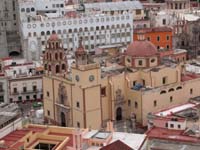
It was raining again the next morning! And cold. We scarfed down spicy chilaquiles and cupped close hot cups of coffee in the hotel restaurant where the doors stood thrown open despite the weather and temperatures!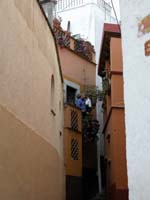 The rain had not abated as we hoisted our backpacks to make the schlep a mile to the car where it was parked in the main tunnel. Imagine, public parking in an underground tunnel! This main tunnel, as I mentioned, once was the course of the river, so, from the houses overhead stuck out the original 17th and 18th century privies, fortunately now non-functional. Still, in the dripping environment they gave one pause. The river's course was diverted elsewhere after it flooded the city in 1905, starting the movement of putting roads under the city. Flooding was still an issue the week we were there with the unusual amount of rain drenching Mexico. We were diverted from the turn we thought we wanted into another tunnel that fortuitously took us right where we'd wanted to go in the first place. With a final wave over our shoulder to the monument to Don Quixote and Sancho Panza (Guanajuato has a three-week arts festival dedicated to Cervantes in October), we were out of the maze and on our way to Zacatecas. The rain had not abated as we hoisted our backpacks to make the schlep a mile to the car where it was parked in the main tunnel. Imagine, public parking in an underground tunnel! This main tunnel, as I mentioned, once was the course of the river, so, from the houses overhead stuck out the original 17th and 18th century privies, fortunately now non-functional. Still, in the dripping environment they gave one pause. The river's course was diverted elsewhere after it flooded the city in 1905, starting the movement of putting roads under the city. Flooding was still an issue the week we were there with the unusual amount of rain drenching Mexico. We were diverted from the turn we thought we wanted into another tunnel that fortuitously took us right where we'd wanted to go in the first place. With a final wave over our shoulder to the monument to Don Quixote and Sancho Panza (Guanajuato has a three-week arts festival dedicated to Cervantes in October), we were out of the maze and on our way to Zacatecas.
The drive from Guanajuato to Zacatecas was about five hours long, The autopista (yes, we found it) took us around the industrial cities of Leon and Aguascalientes, the road rising steadily, the landscape becoming drier and drier with every mile, and, miracle of miracles, the sky seeming to clear! The highway suddenly dog-legged to the left and led us into a city wedged into a narrow valley beneath Cerro de la Bufa. To the modern traveler, this penchant for siting cities in gorges and ravines seems odd with so much open plain around, but of course the draw for the original settlers was water and mining. And in the mining department, Zacatecas was one of Mexico's richest spots, which therefore means it is now one of Mexico's
"richest" troves of colonial architecture.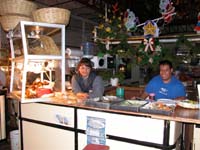
Still, it is a nightmare for driving. We joined what felt like it must be a perpetual traffic jam, inching into the city up narrow one-way streets, passing the likes of the Howard Johnson Hotel at $110 a night in hopes the flow would deposit us at a more affordable hotel. It did eventually lead us to the very agreeable and friendly Hotel Condesa, but believe you me, in the course of the next two days we were all privately wondering if the Howard Johnson might have heat! At 2445m (approx 7400') high in a particularly cold week in January, the temperatures hovered in the chilly 40s, often with a wind, usually overcast, and occasionally with sprinkles. One morning we actually saw flurries--yes, as in the white stuff! Yet like everywhere else in Mexico, the doors and windows stand open to the restaurants, stores, and even museums while the workers go about their business in parkas and gloves! Thank God, the Mexicans do know how to pile on the blankets!
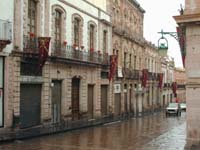 Fortunately (I guess) the momentum for touring was up, and we launched ourselves out into the streets regardless of the environment, taking in markets, stores, churches and museums--although we were disappointed if we thought the any of them would provide warmth. Zacatecas has some beautiful churches. The most striking was appropriately the pink stone cathedral whose three carved-stone facades are described as the
"ultimate expression of Mexican baroque" (Lonely Planet), while its inside was the most understatedly elegant of all those we'd seen on the trip. Zacatecas also has a number of excellent museums. We spent hours in the Museo Pedro Coronel which displays what was the private (and very eclectic) collection of art and artifacts from around the world originally belonging to an obviously very successful Zacatecan native. Fortunately (I guess) the momentum for touring was up, and we launched ourselves out into the streets regardless of the environment, taking in markets, stores, churches and museums--although we were disappointed if we thought the any of them would provide warmth. Zacatecas has some beautiful churches. The most striking was appropriately the pink stone cathedral whose three carved-stone facades are described as the
"ultimate expression of Mexican baroque" (Lonely Planet), while its inside was the most understatedly elegant of all those we'd seen on the trip. Zacatecas also has a number of excellent museums. We spent hours in the Museo Pedro Coronel which displays what was the private (and very eclectic) collection of art and artifacts from around the world originally belonging to an obviously very successful Zacatecan native.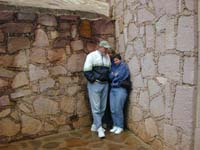
We also very much enjoyed an exhibit of the yarn art traditions of the Huichol Indians. In tourist centers like Puerto Vallarta, special
"galleries" display the distinctively psychedelic artwork (both yarn paintings and in recent years, three-dimensional beadwork (actually glued to ceramic or wooden forms) to catch the eye
-- and wallet -- of the gringo shopper. The exhibit in the Museo Zacatecano was subtler and more focused on the real traditions and lifestyle. The Huichol are one of Mexico's most independent indigenous groups, living in the remote mountain regions between Puerto Vallarta and Zacatecas and annually making long pilgrimages across rugged terrain to collect from mescal cacti, the hallucinogenic peyote that drives their spiritual, cultural and artistic lives.
Probably the two most popular attractions in Zacatecas are the Eden Mine tour and the ride to the top of Cerro Bufa in the teleferico. The teleferico is a ski gondola-type ride that crosses the city from one hill top to another. City map in hand on a bright blustery morning we climbed to the Eden mine entrance nearest the teleferico. We arrived early and huddled in the corner out of the winds until opening time came and went. 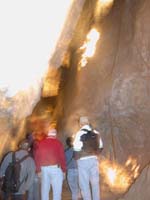 Also no sign of life at the teleferico which we could see across the way. We were joined by a solitary young Japanese tourist who was even more underdressed than we were, and waited another fifteen minutes shivering and huddling before we decided to hike down to the other entrance to the mine. There we found life--but not much. Only one other couple was waiting for the tour, but fortunately they spoke English well and could translate for our guide--although he stumped her occasionally with some ribald jokes and plays on words. The seven of us climbed onto a tiny train and rode it deep into the mountainside. Although the mine, which was in operation almost four hundred years, was one of the richest in Mexico with gold, silver, iron, copper and zinc, it was pure hell for its workers, most them enslaved indigenous peoples who spent their whole lives inside. Lit very effectively with mood lighting, the Eden mine was like something out of an Indiana Jones movie. Excavation followed the veins, so the caves twist away in open caverns up and down, with suspension bridges and tiny shrines. The mine once went seven layers down, but during a period when it was shut down, the lowers levels flooded. The fourth level is the one we visited on the tour, and we understand that at night there is a popular discotheque in one of the mine's chambers, that, not even opening until after nine thirty, we did not visit! At the end of the tour we were ushered to and elevator that disgorged us back at the windblown upper entrance. The
teleferico, which does not operate in winds over 60 km/h was not operating. Also no sign of life at the teleferico which we could see across the way. We were joined by a solitary young Japanese tourist who was even more underdressed than we were, and waited another fifteen minutes shivering and huddling before we decided to hike down to the other entrance to the mine. There we found life--but not much. Only one other couple was waiting for the tour, but fortunately they spoke English well and could translate for our guide--although he stumped her occasionally with some ribald jokes and plays on words. The seven of us climbed onto a tiny train and rode it deep into the mountainside. Although the mine, which was in operation almost four hundred years, was one of the richest in Mexico with gold, silver, iron, copper and zinc, it was pure hell for its workers, most them enslaved indigenous peoples who spent their whole lives inside. Lit very effectively with mood lighting, the Eden mine was like something out of an Indiana Jones movie. Excavation followed the veins, so the caves twist away in open caverns up and down, with suspension bridges and tiny shrines. The mine once went seven layers down, but during a period when it was shut down, the lowers levels flooded. The fourth level is the one we visited on the tour, and we understand that at night there is a popular discotheque in one of the mine's chambers, that, not even opening until after nine thirty, we did not visit! At the end of the tour we were ushered to and elevator that disgorged us back at the windblown upper entrance. The
teleferico, which does not operate in winds over 60 km/h was not operating.
Perhaps our stomachs govern our lives too much, but the highlight of our stay in Zacatecas, and indeed the culinary highlight of the whole trip was a dinner we had here one rainy night at Los Dorados de Oro. For details ee our write up #22 on Colonial Mexico in the Galley Section of the website.
From Zacatecas we drove south on a beautiful sunny morning on Mexico Highway 54. This was NOT an autopista, but on a Sunday morning there was virtually no traffic and the landscape was stunning every bit of the way. In the towns the residents gathered in their finery for church, and the on vast ranges of the mountainside, cattle crazed behind stone walls that ran for miles and miles. Just north of Guadalajara we stopped at a park offering an overlook to a spectacular waterfall which we had seen from 20 miles off. It most countries this would be a major attraction, but we never found it mentioned in any of our tourist guides!
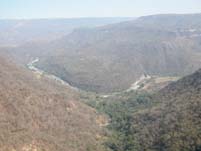 Instead of turning the car straight back into Guadalajara, we bore away westward to do the most touristy thing of our whole trip--to visit the city of Tequila, center
-- yes, you guessed it -- of the world's tequila industry. Tequila is such a part of Mexico and, incidentally our generation that it was a pilgrimage we really couldn't miss. It ended up being a pretty interesting day. Again, for details see our write up #23 in our Galley section. Instead of turning the car straight back into Guadalajara, we bore away westward to do the most touristy thing of our whole trip--to visit the city of Tequila, center
-- yes, you guessed it -- of the world's tequila industry. Tequila is such a part of Mexico and, incidentally our generation that it was a pilgrimage we really couldn't miss. It ended up being a pretty interesting day. Again, for details see our write up #23 in our Galley section.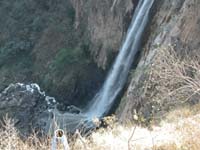 Our weeklong day trip wound up back in Tlaquepaque where we tried a B&B Lisa had been wanting to check out, the Casa de Las Flores Our weeklong day trip wound up back in Tlaquepaque where we tried a B&B Lisa had been wanting to check out, the Casa de Las Flores
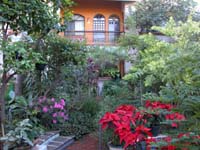 . This B&B is even more charming than the Quinta Don Jose, with, as the name would suggest, a garden full of lush flowers and rooms filled with art. For dinner we chose not to trek the four or five blocks to any of the trendy restaurants, but instead to eat at a little local Mom and Pop spot right across the street where we were the only gringos and where a really good dinner cost us maybe $5pp! Surely what most warmed the cockles of the . This B&B is even more charming than the Quinta Don Jose, with, as the name would suggest, a garden full of lush flowers and rooms filled with art. For dinner we chose not to trek the four or five blocks to any of the trendy restaurants, but instead to eat at a little local Mom and Pop spot right across the street where we were the only gringos and where a really good dinner cost us maybe $5pp! Surely what most warmed the cockles of the 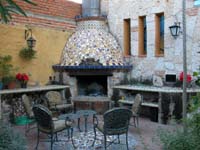 Two Captains hearts at Casa de Las Flores (literally), was the home-made tequila cake served before bed in the open garden WARMED by a huge tile outdoor fireplace. The hospitality of our host, TKTK , was personal and gracious, and the wonderful breakfast the next morning -- an egg crepe
-- was delicious -- and also didn't suffer from being served in a heated breakfast room!
It would have been very easy to spend a few more days just lounging in Tlaquepaque at the Casa de Las Flores, but as usual, the minds of all four of us were turning to the future. Dennis and Lisa had a schedule to keep to meet friends in Manzanillo, and we had the applications for our French visas to get in the works--not to mentions some boat projects. With regret we turned in our rental car and climbed aboard the bus bound for
Mazatlán. Two Captains hearts at Casa de Las Flores (literally), was the home-made tequila cake served before bed in the open garden WARMED by a huge tile outdoor fireplace. The hospitality of our host, TKTK , was personal and gracious, and the wonderful breakfast the next morning -- an egg crepe
-- was delicious -- and also didn't suffer from being served in a heated breakfast room!
It would have been very easy to spend a few more days just lounging in Tlaquepaque at the Casa de Las Flores, but as usual, the minds of all four of us were turning to the future. Dennis and Lisa had a schedule to keep to meet friends in Manzanillo, and we had the applications for our French visas to get in the works--not to mentions some boat projects. With regret we turned in our rental car and climbed aboard the bus bound for
Mazatlán.
.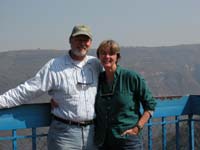 |